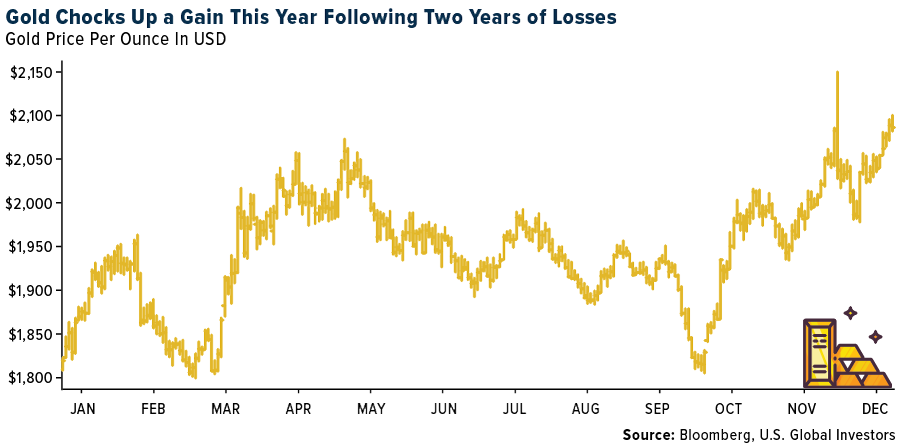Strengths
- The best performing precious metal for the year was gold, up 7.93%. The yellow metal is up for the year, after two years of losses, while the dollar is down, falling 5% just in the last two months of the year. The greenback has weakened as U.S. interest rates are near a peak and the Federal Reserve’s aggressive tightening begins to take a toll on the world’s largest economy, investors say.

- Goldman thinks there will be continued focus on M&A in the gold sector given the supportive gold price environment and strong balance sheet positions, including potential impacts to NAV upon the proposed implementation of the Global Minimum Tax in 2024. Goldman views the gold streaming/royalty companies as attractive business models given the elevated gold price environment and flattish cost structure, underpinning 70-80% EBITDA margins and above gold mining peers of 40-50%.
- The merger of Newmont and Newcrest will be the largest gold company in the world, with a market cap of $57 billion, producing 8-8.5 million ounces gold per annum at AISC of $1,065 per ounce, with total gold reserves of 155 million ounces and total resources of 333 million ounces, with a mine life of 17. The proposed offer appears accretive to NAV and relatively neutral to near-term financial metrics based on consensus estimates.
Weaknesses
- The worst performing precious metal for the year was palladium, down 40.35%. Palladium dropped to the lowest levels in five years as demand falters amid a slowdown in car sales, the rise of electric vehicles, and as users switch to cheaper platinum. The metal, which is almost entirely used in catalytic converters that curb emissions, has slumped this year as slowing economic growth hurt global automobile sales.
- Most companies assume inflationary pressures seen in 2023 will persist into 2024, but slowly taper off thereafter. Newmont's five-year outlook, which saw long-run cash costs increase $50 per ounce, or around 7% from the prior guide, and sustaining capex up $175 million annually. Higher gold prices will be needed to offset this.
- The value of polished diamond stone exports from India – a proxy for demand – was down 31% this year, while volumes decreased by 29%, implying aggregate prices declined possibly due to a mix change. Polished diamond export volumes and value came in below the five-year average.
Opportunities
- Yamana’s founder Peter Marrone commented that the gold sector will likely see more M&A as miners look to maintain margins in a higher cost and lower gold grade environment. He says, “The gold price today is roughly where it was in late 2020…but interestingly, the margins have decreased quite substantially for almost all of the companies.” According to Marrone, “It seems to me, that we are going into universally lower grades, higher costs, inflationary impacts,” he continued, meaning “any form of consolidation is a smart one.”
- According to Google Trends data, the phrase “how to buy gold” has reached record levels in the U.S. (even higher than when gold prices reached all-time highs in 2020). Investors are concerned about sticky inflation, elevated interest rates for longer, and/or a potential recession – these are all scenarios that historically have been positive for gold. When the economy is unstable, as many investors felt throughout the year, consumers turn to the yellow metal, and 2023 was no different. Some of the nation’s biggest retailers like Costco, Walmart and Amazon all sold gold bars, and many times sold out, this year.

- Measured using the ratio of gold prices to S&P 500 total returns, the metal has comfortably come out on top from the start to the end of each of the past three U.S. recessions. During the 2000 recession, the ratio went from 0.15 to 0.17 over the period defined by NBER. During the global financial crisis, it nearly doubled from 0.34 to 0.62, and in the Covid recession, it climbed from 0.23 to 0.28.
Threats
- Morgan Stanley’s historical analysis on gold, which has focused on real yields versus real gold price, has been shifting. Running this analysis had an R-Square of 92% in 2018-2021, which fell to 63% in 2022 and is now just 30%. This would imply gold somewhere below $1,300 per ounce. Morgan Stanley’s price forecasts have pushed out the timing of peak prices and brought targets down modestly, now calling for gold to reach $2,100 per ounce by the first quarter 2024.
- Gold purchases in India dropped to the lowest since the COVID-19 pandemic hit the second-biggest consuming nation in 2020, with high domestic prices deterring buyers. Indians are expected to have bought between 650 and 750 tons of the precious metal in 2023, said P.R. Somasundaram, the regional chief executive officer for India at the World Gold Council. The range is lower than the 774 tons bought in 2022 and the least since the 446 tons purchased in 2020, according to the London-based group’s data.
- According to Bank of America, when it comes to diamonds, the group believes that higher rates and weaker growth could put the consumer under pressure, translating into less diamond demand and downward pressure on prices. The bank now models slower price recovery.

